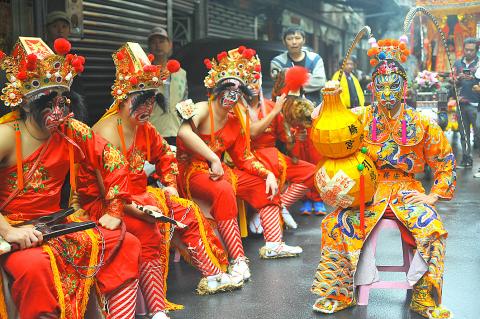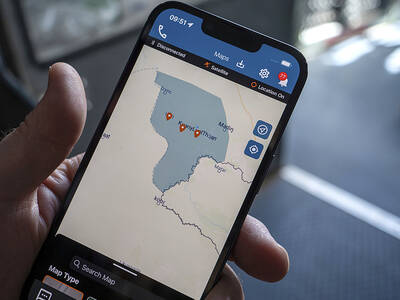It was a historic moment as several men and women fumbled with their swords, maces and ancient torture devices outside Banciao’s Ling An Temple (靈安宮). These first timers awkwardly moved in two concentric circles, trying to replicate the bajiang (八將, or “eight armed guards”) steps they just learned from the temple’s unique religious troupe.
Saturday was the first time that the 37-year-old temple, located in New Taipei City’s Banciao District (板橋), offered a bajiang lesson to the public. A gray-haired Hung Teng-hsing (洪登興), whose late father founded the temple, watches amusedly. When asked if this group was fit to take over as the temple’s fourth generation bajiang troupe, he laughed: “Yes, you all pass.”

Photo: Han Cheung, Taipei Times
He was only joking, as the third generation would be embarking on their first religious procession as a complete group for the birthday of patron deity Qingshanwang (青山王, or “Green Mountain King”) the next day.
The temple is experiencing many changes as Hung passes on the torch to the younger generation, who are using new methods to promote temple culture.
While two other temples in Taipei also worship Qingshanwang, Ling An Temple boasts the only bajiang troupe in Taiwan, where its members experience jiangjia (降駕), or becoming possessed by the deity.
FAMILY AFFAIR
Hung Teng-hsing’s niece, Hung Yi-hsuan (洪藝瑄), has mostly taken over organizational duties for the annual procession, noting that although she grew up in the temple, she only became involved three years ago when she turned 23.
“Before our 35th anniversary, everything was done by my uncle and the older generation,” Hung Yi-hsuan says. “That year, he thought that he should get us involved, and I ended up being in charge because of my interest in temple culture. We’re still slowly learning the ropes as they support us from behind.”
Hung Yi-hsuan says other family members have also joined, as her sister documents the procession with a GoPro. Her nephew is not only a bajiang troupe member, but has also created a series of temple promotional products.
“It’s a family affair. We are all deeply involved with the worship of [Qingshanwang],” she says. “But from a religious standpoint, it’s also spiritual sustenance as well. It’s just a part of our daily life.”
Hung says the first change she made was to set up a Facebook fan page for the temple, sharing photos, videos and information.
This year, in conjunction with Gods School (廟會小學堂), which puts on educational activities with various temples across Taiwan, Ling An Temple held its first seminar, where temple personnel and former bajiang troupe members shared their experiences. Several videos were screened for the first time.
The bajiang lesson was part of the event. There are no taboos in letting the public try the steps, but precautions were still taken as participants had to cleanse their hands with incense smoke, while “fake” weapons were provided to women as they are not allowed to touch the devices used during the procession.
“Our main goal is to propagate [Qingshanwang’s] divine power and preserve the bajiang tradition,” Hung says.
COMBATING STEREOTYPES
Tseng Huan-hsun (曾煥勛) is one of the new bajiang members. An interior designer, Tseng had little temple experience growing up until his friend recruited him three years ago.
“I thought it would be a good idea to serve the deities,” he says.
His family was initially against it, as the public continues to believe that temple troupes involve gangs, fighting and drugs, something that’s only done by delinquents.
“But they also came to the temple when they had trouble and they felt that this was a kind and gentle place. I didn’t become ‘bad.’ I became more grounded,” Tseng says.
Tseng added that his friends still ask him why he participates every year, as they also harbor those stereotypes.
“But I feel that this place is different. We’re not having a procession just to have a procession, or to make money. We’re doing it purely for the gods.”
Audience members on Saturday mostly consisted of people in their 20s and 30s, and Hung has noticed a growing interest in Taiwanese folk culture among the younger population — especially temple culture, much of which is unique to Taiwan.
“It’s good to take an interest, but set aside your preconceptions. Get to know what’s going on first.”

Desperate dads meet in car parks to exchange packets; exhausted parents slip it into their kids’ drinks; families wait months for prescriptions buy it “off label.” But is it worth the risk? “The first time I gave him a gummy, I thought, ‘Oh my God, have I killed him?’ He just passed out in front of the TV. That never happens.” Jen remembers giving her son, David, six, melatonin to help him sleep. She got them from a friend, a pediatrician who gave them to her own child. “It was sort of hilarious. She had half a tub of gummies,

June 23 to June 29 After capturing the walled city of Hsinchu on June 22, 1895, the Japanese hoped to quickly push south and seize control of Taiwan’s entire west coast — but their advance was stalled for more than a month. Not only did local Hakka fighters continue to cause them headaches, resistance forces even attempted to retake the city three times. “We had planned to occupy Anping (Tainan) and Takao (Kaohsiung) as soon as possible, but ever since we took Hsinchu, nearby bandits proclaiming to be ‘righteous people’ (義民) have been destroying train tracks and electrical cables, and gathering in villages

The wide-screen spectacle of Formula One gets a gleaming, rip-roaring workout in Joseph Kosinski’s F1, a fine-tuned machine of a movie that, in its most riveting racing scenes, approaches a kind of high-speed splendor. Kosinski, who last endeavored to put moviegoers in the seat of a fighter jet in Top Gun: Maverick, has moved to the open cockpits of Formula One with much the same affection, if not outright need, for speed. A lot of the same team is back. Jerry Bruckheimer produces. Ehren Kruger, a co-writer on Maverick, takes sole credit here. Hans Zimmer, a co-composer previously, supplies the thumping

Swooping low over the banks of a Nile River tributary, an aid flight run by retired American military officers released a stream of food-stuffed sacks over a town emptied by fighting in South Sudan, a country wracked by conflict. Last week’s air drop was the latest in a controversial development — private contracting firms led by former US intelligence officers and military veterans delivering aid to some of the world’s deadliest conflict zones, in operations organized with governments that are combatants in the conflicts. The moves are roiling the global aid community, which warns of a more militarized, politicized and profit-seeking trend